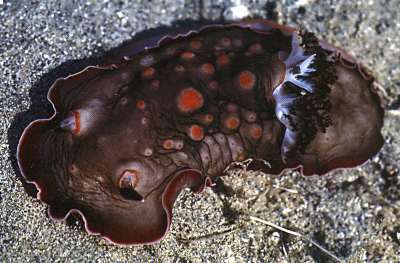
Aphelodoris karpa
Wilson, 2003
Order: NUDIBRANCHIA
Suborder: DORIDINA
Superfamily: EUDORIDOIDEA
Family: Dorididae
DISTRIBUTION
Known only from Shark Bay, Western Australia to Gove Peninsula, Nthn Territory, Australia.
PHOTO
Enderby Island, Dampier Archipelago, Western Australia. Photo: C. Bryce. Paratype. AM C204865.
-
Wilson, N. G. (2003). Australian Aphelodoris (Mollusca: Nudibranchia): two new species, sperm ultrastructure and a redescription of Aphelodoris greeni Burn. In: F. E. Wells and D. I. Walker (eds), The Marine Flora and Fauna of Dampier, Western Australia. Western Australian Museum, Perth. Volume 2: 563-587
Rudman, W.B., 2006 (February 7) Aphelodoris karpa Wilson, 2003. [In] Sea Slug Forum. Australian Museum, Sydney. Available from http://www.seaslugforum.net/find/aphekarp
Related messages
Charging slug? - Aphelodoris karpa
December 14, 2006
From: Hans Kemps
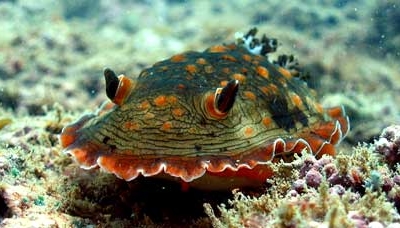
Dear Slug Forum,
A friend of mine phtographed this charging dorid at Ningaloo Reef. Would you be able to help us with the identification and an explanation for this unsluglike behaviour? Thank you!
Locality: Ningaloo Reef, 10 m, Western Australia, Indian Ocean. Photographer: Craig Kitson.
Kind Regards,
Hans Kemps
hakemps@mirg.org.au
Kemp, H., 2006 (Dec 14) Charging slug? - Aphelodoris karpa. [Message in] Sea Slug Forum. Australian Museum, Sydney. Available from http://www.seaslugforum.net/find/18997Dear Hans,
It's a bit hard from a still photo to get the feeling that it is 'charging towards the viewer' but it certainly seems to be off the ground so I'll take your word that it was moving towards the photographer with unsluglike haste.
As it happens I think I have an explanation for you. This dorid, Aphelodoris karpas, has only recently been descibed so we know very little about its biology. However one thing that Nerida Wilson noted about this animal in her description was that it can swim by an up and down [dorso-ventral] flexion of the whole body, much like the Spanish Dancer, Hexabranchus sanguineus. I have no idea how fast they swim once they are moving, but certainly it is much faster than they crawl. You don't mention how large the animal was, but this species can reach at least 10 cm in length - so I guess if you saw something that size swimming towards your camera lens you could describe it as 'charging'. But 'charging' suggests they are aiming at something, and I am afraid that nudibranchs, although they have small eyes, are effectively blind, so the direction they travel in when swimming, is quite by chance.
Best wishes,
Bill Rudman
Aphelodoris karpa with shrimp from Ningaloo
February 17, 2006
From: Kristin Anderson
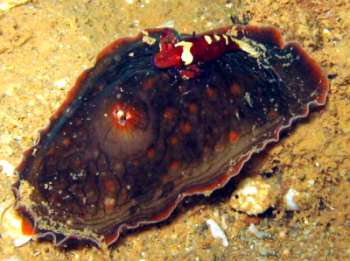
Bill -
Concerning your comment about the commensal shrimp [#15824], here's an old photo with a single shrimp. I have another with a second shrimp but there's a ton of backscatter in it!
Locality: Exmouth Gulf, 18m, Western Australia, Exmouth Gulf, Ningaloo Reef, 30 January 2004, tidal, silty. Length: 8-9 cms. Photographer: Kristin Anderson
Kristin Anderson
kristin@OceansByAnderson.com
Anderson, K.J., 2006 (Feb 17) Aphelodoris karpa with shrimp from Ningaloo. [Message in] Sea Slug Forum. Australian Museum, Sydney. Available from http://www.seaslugforum.net/find/15845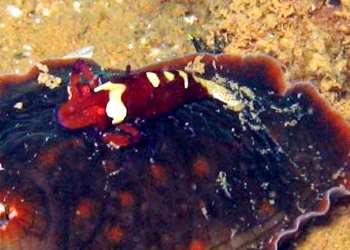
Thanks Kristin,
Yes this is almost certainly Periclimenes imperator. It is darker red and the white patches are reduced to small streaks in your animal, but otherwise the colour pattern is identical [see message #14726].
Best wishes,
Bill Rudman
Aphelodoris karpa from Ningaloo Reef
February 12, 2006
From: Kristin Anderson
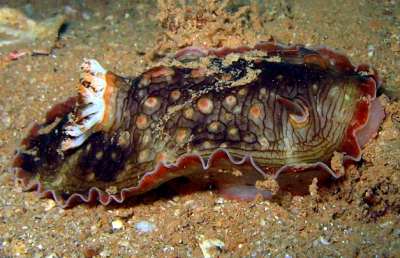
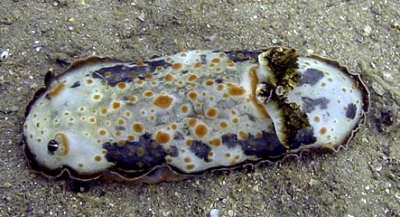
Bill -
Just saw the new fact sheets and thought I would these two shots of Aphelodoris karpa.
I've had them as Aphelodoris sp for a while now and wondering if one or both might be this newly added species?
They often have bright red shrimp on them, too.
Locality: Exmouth Gulf, Ningaloo Reef, 18 & 22m, Western Australia, Exmouth Gulf, late 03 & January 04, silty, tidal. Length: 8-9 cm. Photographer: Kristin Anderson
Kristin Anderson
kristin@OceansByAnderson.com
Anderson, K.J., 2006 (Feb 12) Aphelodoris karpa from Ningaloo Reef. [Message in] Sea Slug Forum. Australian Museum, Sydney. Available from http://www.seaslugforum.net/find/15824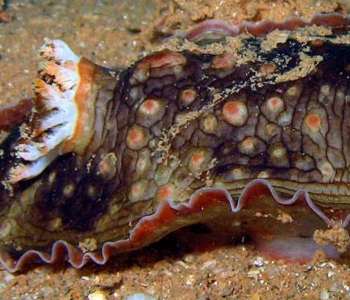
Dear Kristin,
That was a quick response. Yes I would sat they are both A. karpa. It's nice to see examples of its colour variability. It would be interesting to see more examples of A. gigas. It seems to have quite a few similarities to A. karpa in some of its colour variations.
Interesting to hear about the red shrimp. It is possibly Periclimenes imperator, which is usually associated with Hexabranchus sanguineus, but is found with quite few large opisthobranchs.
Best wishes,
Bill Rudman
